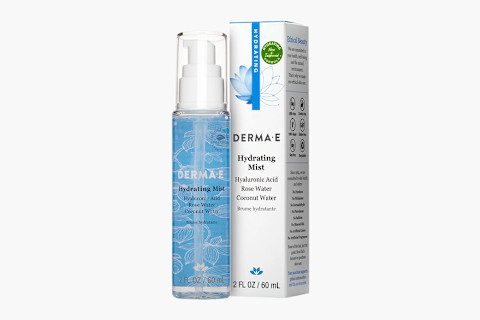How To Add Hyaluronic Acid To Your Routine In The Dead Of Winter

In the world of skincare, hyaluronic acid is an ingredient worth its weight in hydration gold. While its name may sound harsh, it is, in fact, anything but.
“Hyaluronic acid is a naturally occurring type of sugar that is produced by the body and found in the highest concentrations in our skin, connective tissue, and eyes,” says board-certified dermatologist Jennifer Chwalek, M.D. “It functions to retain water, keep our tissues well lubricated, and our skin looking firm and youthful,” she says. “It also helps to speed up wound healing by regulating inflammation levels and blood vessel formation, and can increase collagen production, which is another way it can help our skin as we age.”
And because hyaluronic acid binds to water, it can keep skin hydrated longer, and more effectively, combating dryness, says nutritionist Nicolette Pace, R.N. “This is very important now with cold, dry weather and indoor heating,” she says.
How to get more hyaluronic acid
When hyaluronic acid is applied topically, in forms such as gels, creams, serums, or mists, the safe-for-all-skin-types ingredient “helps to increase and retain skin’s moisture, combat dryness, soothe irritation, and improve the appearance of fine lines, texture, and roughness,” Dr. Chwalek says. Ideally, you want to apply HA after cleansing when your skin is still damp. This will provide some moisture for the HA to better absorb, she says.
Hyaluronic acid is also found in a variety of foods, which boosts your body's natural ability to produce more of it, Pace says. Now that winter—and its accompanying dry, dehydrating weather—is here, adding this hydration helper to both your skincare regimen and diet is super important. Here are five ways to reap the benefits on the reg.
5 ways to add hyaluronic acid to your winter routine
Add a gel boost.
You may think you have your daily skincare steps down to a science, but if you’re not starting with a hyaluronic acid-based formula, you’re missing out on some major moisture, especially in the colder months.
Lay a hydrating foundation with DERMA E Ultra Hydrating Alkaline Gel Booster. Formulated with hyaluronic acid and alkaline water to increase moisture levels, this lightweight gel replenishes and balances skin’s natural moisture barrier and reduces the appearance of fine lines for a supple, healthy glow. Apply a few drops morning and night to your face and neck under your moisturizer or use it alone.
Bone up on broth.
A bowl of steamy bone broth is one of the best ways to get your fill of hyaluronic acid straight from nature—since HA is contained in the bones themselves, Pace says. After slow cooking beef or chicken bones in water for about eight hours, the HA, as well as other nutrients including collagen, the support structure for the skin, is released into the broth. Pace recommends adding veggies like carrots, celery, leeks, and onions as well as garlic, two teaspoons of peppercorns, and a tablespoon of cider vinegar for a savory stock.
Mist the day away.
Whether you (and your skin) need an afternoon lift or a refreshing hit of hydration when skin feels dry and tight, a mist rich in hyaluronic acid is your best moisture magnet—and wakeup call. Try DERMA E Hydrating Mist, which quenches your skin with hyaluronic acid, antioxidant-rich rose water, and hydrating coconut water. Keep it at your desk to spritz yourself throughout the day. The beauty is, it will set, not smear your makeup and impart a dewy glow.
Savor some starchy veggies.
Craving some carbs? Have a helping of root vegetables such as potatoes, sweet potatoes, Jerusalem artichokes, or jicama with dinner. These types of foods can speed the production of hyaluronic acid in the body. This is because they’re rich in magnesium, which stimulates the body’s synthesis of HA, Pace says. Additionally, they contain high levels of vitamin C, potassium, fiber, and antioxidants, which support skin health as well—wins all around.
Consider a supplement.
Taking a dietary supplement of hyaluronic acid has also been shown to improve wrinkles, skin elasticity, and hydration. According to a study in the Journal of Clinical, Cosmetic and Investigational Dermatology1, researchers found that the oral ingestion of HA over a 12-week period was proven to suppress wrinkles and improve skin’s luster and suppleness. For optimal skin hydration and health, Pace recommends taking 120 to 240mg per day in addition to eating HA-rich foods and incorporating the ingredient into your skincare regimen topically.


